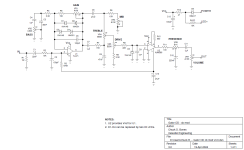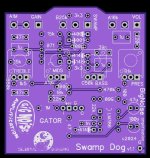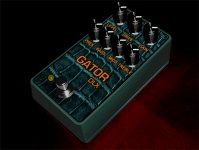You are using an out of date browser. It may not display this or other websites correctly.
You should upgrade or use an alternative browser.
You should upgrade or use an alternative browser.
This Week on the Breadboard: Gator's OD - cb mod
- Thread starter Chuck D. Bones
- Start date
Chuck D. Bones
Circuit Wizard
I might fiddle a capacitor value or two, but other than that, it's finished.
Chuck D. Bones
Circuit Wizard
The Gator
Well-known member
At the risk of sounding like a complete suck ass...
You are awesome Dave!!!
Thank you for taking interest in my original moded circuit and taking it to a new level!
The thing I noticed about overdrives and distortions is that high gain circuits tend to sound like crap at low gain settings. Low gain circuits usually only do just that, and usually only soft clipping.
Being able to blend and go from super light to heavy gain is fun and useful for several genres of music. All in one circuit. Now, with plenty of tone shaping on tap!
I'm going to breadboard it this weekend. I just started playing with a group of old friends so I might just take it to band practice as a breadboard...lol
Thank you!
~Gator
You are awesome Dave!!!
Thank you for taking interest in my original moded circuit and taking it to a new level!
The thing I noticed about overdrives and distortions is that high gain circuits tend to sound like crap at low gain settings. Low gain circuits usually only do just that, and usually only soft clipping.
Being able to blend and go from super light to heavy gain is fun and useful for several genres of music. All in one circuit. Now, with plenty of tone shaping on tap!
I'm going to breadboard it this weekend. I just started playing with a group of old friends so I might just take it to band practice as a breadboard...lol
Thank you!
~Gator
Last edited:
Chuck D. Bones
Circuit Wizard
There's by the way two caps both labelled C5 on latest schematic.
Chuck D. Bones
Circuit Wizard
Schematic has been corrected. 
Feral Feline
Well-known member
CDB, I noticed the last two iterations of the schematic were both labeled "Gator OD cb mod v3.0.png"
Maybe the one with rewired presence pot in Post #23 can be v3.1?
The Gator, I like the idea of going 1590BB2 — then you can add one more knob* and stomper to make it a combo pedal.
*One-knob boost/Fuzz/Phaser/whatever
Cool stuff, I've put all this info in my Boneyard folder, so as not to be confused with the PAIA Gator in the PAIA folder.
Maybe the one with rewired presence pot in Post #23 can be v3.1?
The Gator, I like the idea of going 1590BB2 — then you can add one more knob* and stomper to make it a combo pedal.
*One-knob boost/Fuzz/Phaser/whatever
Cool stuff, I've put all this info in my Boneyard folder, so as not to be confused with the PAIA Gator in the PAIA folder.
Chuck D. Bones
Circuit Wizard
It's such a minor change that I chose to not roll the rev #. It was a judgement call.CDB, I noticed the last two iterations of the schematic were both labeled "Gator OD cb mod v3.0.png"
Maybe the one with rewired presence pot in Post #23 can be v3.1?
Chuck D. Bones
Circuit Wizard
Latest rev. Gator is contemplating further changes, but this is where I am today. The LM386 is gone; we're back to a dual opamp. Tone controls redone. The LM386 loaded the MID network too much and didn't do anything special for the tone. The MID control is cut only, centered at about 700Hz. The TREBLE control is a shelving filter, like the BD-2 TONE control. It cuts treble above 1KHz. The PRESENCE control is a variable-freq low-pass filter. At zero, it cuts off at 500Hz. At 10, it cuts off at 9KHz. With DRIVE below 5 (noon), the 2nd stage does not clip. Somewhere above noon, depending on the GAIN setting and guitar volume, the 2nd stage starts clipping.
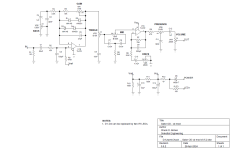
Knobs (L-R): VOLUME - PRESENCE - MID - TREBLE - DRIVE - BASS - GAIN. I tried 5 different dual opamps: TL072, LM833 (installed), NE5532, CA3240, NJM4558.
TL072 sounds good, good output volume, fairly symmetric clipping.
LM833 sounds good, slightly higher output volume, nearly symmetric clipping.
CA3240 and NE5532 do not work well in this circuit. Very asymmetric clipping.
NJM4558 sounds good, good output volume, fairly symmetric clipping.
I used IR LEDs for the soft clipping.


Knobs (L-R): VOLUME - PRESENCE - MID - TREBLE - DRIVE - BASS - GAIN. I tried 5 different dual opamps: TL072, LM833 (installed), NE5532, CA3240, NJM4558.
TL072 sounds good, good output volume, fairly symmetric clipping.
LM833 sounds good, slightly higher output volume, nearly symmetric clipping.
CA3240 and NE5532 do not work well in this circuit. Very asymmetric clipping.
NJM4558 sounds good, good output volume, fairly symmetric clipping.
I used IR LEDs for the soft clipping.

The Gator
Well-known member
Here are my simple changes.
Nothing necessary, just something I believe will be useful get different tones when playing gigs.
I Changed the drive pot VR5 to a dual C50K pot. The C taper get to the hard clipping sooner. The second pot is VR8 and is in between the volume pot C7 and C12. It can be added or removed from the circuit via SW1.
if you think about the drive, much like an incandescent light bulb,the main product is heat, and the secondary product is light. The drive pots main product is DB gain, and the secondary product is hard clipping. (This also comes with what seems to be some compression and treble increase.) If you were wanting to change your sound on the Fly when playing live at a gig, you really wouldn't want to have to re-adjust your DB level when you do that. With a double pot you wouldn't have to. It would just add in the compression, treble boost and hard clipping to the sound completely changing the tone from just soft clipping. You would not lose your volume setting and not have to fiddle with your volume again. This could be put on a toggle switch so that one mode is Drive and boost. The other mode is just drive. It could also be run through a foot switch. That way between the toggle and the foot switch it could be utilized as a boost for solo work which could add hard clipping in or not, depending on where the knob is set, and where the toggle is set.
This makes the versatility of this design extremely useful in a live setting.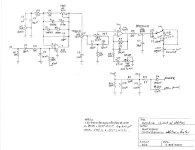
Sorry. I'm still drawing circuits. Anybody know a simple software product that could be used to create circuits neatly?
As you can see I also changed the led resistor 20K to use a green LED cause...Gator...lol
Nothing necessary, just something I believe will be useful get different tones when playing gigs.
I Changed the drive pot VR5 to a dual C50K pot. The C taper get to the hard clipping sooner. The second pot is VR8 and is in between the volume pot C7 and C12. It can be added or removed from the circuit via SW1.
if you think about the drive, much like an incandescent light bulb,the main product is heat, and the secondary product is light. The drive pots main product is DB gain, and the secondary product is hard clipping. (This also comes with what seems to be some compression and treble increase.) If you were wanting to change your sound on the Fly when playing live at a gig, you really wouldn't want to have to re-adjust your DB level when you do that. With a double pot you wouldn't have to. It would just add in the compression, treble boost and hard clipping to the sound completely changing the tone from just soft clipping. You would not lose your volume setting and not have to fiddle with your volume again. This could be put on a toggle switch so that one mode is Drive and boost. The other mode is just drive. It could also be run through a foot switch. That way between the toggle and the foot switch it could be utilized as a boost for solo work which could add hard clipping in or not, depending on where the knob is set, and where the toggle is set.
This makes the versatility of this design extremely useful in a live setting.

Sorry. I'm still drawing circuits. Anybody know a simple software product that could be used to create circuits neatly?
As you can see I also changed the led resistor 20K to use a green LED cause...Gator...lol
Chuck D. Bones
Circuit Wizard
It can be simpler: configure SW1 so it shorts out VR8. Basically, hard-wire SW1 pins 2 and 3 together. No need to disconnect VR8.
So you thought C-taper was superior? True, it does make hard clipping happen at a lower dial setting, but my finding was that B-taper made it easier to dial-in the spot where the 2nd stage just starts to clip. I guess it depends on which part of the knob's rotation you use the most.
I use TinyCAD. It's easy to learn and it's FREE!
So you thought C-taper was superior? True, it does make hard clipping happen at a lower dial setting, but my finding was that B-taper made it easier to dial-in the spot where the 2nd stage just starts to clip. I guess it depends on which part of the knob's rotation you use the most.
I use TinyCAD. It's easy to learn and it's FREE!
Last edited:
Similar threads
- Replies
- 8
- Views
- 599
- Replies
- 6
- Views
- 402
- Replies
- 6
- Views
- 436
- Replies
- 25
- Views
- 2K
- Replies
- 15
- Views
- 979


